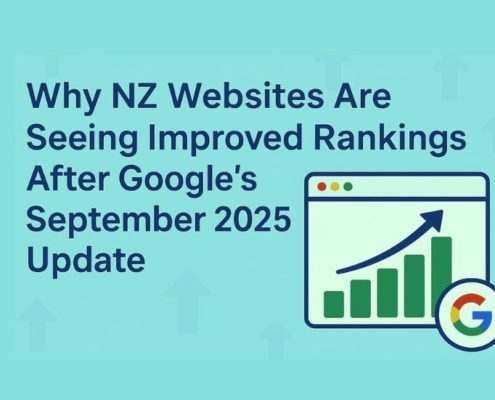A comprehensive digital marketing strategy will help you to achieve this.
Our Digital Marketing Expert explains, “A digital marketing strategy ensures your website gets the support it needs in order to do its job. Both onsite and offsite optimisation are important for any website but that’s just a small percentage of the entire digital marketing process. Getting the site tweaked and enhanced to maximise conversions is just as important as getting the right traffic.”
“Getting 100 visitors per day where 25 end up doing what you want them to on your website is infinitely better than 1,000 visitors with only 5 of them converting. A customised digital marketing strategy planned around your website and your business helps tie up all these loose pieces and gets your online presence to where it should be…delivering ROI.”
Here is an article on the topic by Owen Scott from Concentrate, as published in The Press in 2015:
Busy from blowing cash on fancy signs and hair straighteners, the Ministry for Business Innovation and Employment (MBIE) was being blasted again last week for spending $560,000 on a new website.
$312,261 of the budget was for external costs, the remainder internal resources, for the project that combined the online activities of the various entities that were amalgamated to form MBIE, such as the Ministry for Economic Development, Ministry of Science and Innovation and the Department of Labour.
This follows July reports that the Christchurch City Council had invested $1.2 million in their new website. The project was heavily criticised by the Taxpayers Union, who also slammed the MBIE website.
“The very officials who should be reducing the burden of Government to let New Zealanders further their own lot are the ones spending up large with money pinched from taxpayers’ pockets,” said their executive director Jordan Williams in a statement.
Rather than outrage, my reaction was that this was evidence of how much the concept of a “website” has changed. Increasingly it is about providing customers with access to a business and their services, such as customer service, product support or education.
Although I know exactly nothing about the CCC or MBIE websites, and haven’t had the need to even look at them, I somehow doubt they invested all that public money in a few fancy pages of HTML to extol their virtues to visitors.
Indeed I would hope that their websites connect to back-end computer systems to enable me as a ratepayer/taxpayer to access and use services more easily. That’s what the investment should be judged on, not some perception of what the average website should cost.
Many companies still struggle with this concept, even in the hi-tech sector in which I work. While some, especially those with businesses that are totally online, like a software-as-a-service firms, are very sophisticated, other hi-tech companies still treat their web presence like a fancy sign hanging on their office door.
A modern website is like an employee or even team of employees. Beside Bob in accounts, Sally in customer service and Rudy in dispatch, you should add the staff member “website”.
Websites today act as customer service agents, training providers, quality monitoring teams, order takers and of course sales and marketing staff.
For smaller firms your website should be one of your sales and marketing team, if nothing else. That is, your website employee should be doing the job of helping attract prospective customers to your business, introducing them and warming them up before handing them over to the sales team.
Is this really that important? It is, because almost any demographic of customer will use the internet during their sales process to evaluate and compare your products to others.
As the 2014 Market Measures study of over 300 New Zealand technology companies concluded “If you are not participating in the digital part of the sales process, you are increasingly invisible.”
What are the implications of treating your website as one of the team?
An obvious one is the way it ‘speaks” to people. Would your receptionist say ‘Welcome to company X, we are a leading provider of vertically integrated widgets with a commitment to world class service quality.’?
More likely, they would say ‘Hi how can I help you find what you need.’ That should be the first role of any website.
Too often websites talk mainly about you and not enough about the customer. It is your news, your structure, your people, your products etc.
While that information is relevant, it should be a secondary consideration. Front and centre, a website must be about expressing how you can meet your typical customer’s needs.
A great place to start with your website is trying to document every possible question a prospective customer might ask when evaluating your kind of product, and then reviewing whether your online presence helps them to find an answer.
Another mind-set change is to never accept that you have ‘finished’ your website.
It’s not uncommon for firms to go through a painful, time consuming and expensive process of building a beautiful website, and then simply leave it to its own devices. While that may meet the requirements of your ego, it is unlikely to be acting as that extra employee, attracting and welcoming in prospective new customers.
Just as you wouldn’t employ someone and then leave them to it, with no expectation of development or improvement, a new website is simply a starting platform to build on. The day your website goes live, is the first day of a process of continual reviewing, improving and adding to make it more effective.
Judging public spending through the lens of a traditional website build does make them look like a ridiculous waste of money. If they are actually treating them as “extra employees” for the business, the investment may make a lot more sense.
 https://happymonday.co.nz/wp-content/uploads/2025/10/Why-NZ-websites-are-improving-search-rankings-small.jpg
551
1050
Karen
https://happymonday.co.nz/wp-content/uploads/2021/04/[email protected]
Karen2025-10-21 17:15:392025-10-21 18:02:46Why Are Many NZ Websites Seeing Improved Organic Rankings After Google’s September 2025 Update?
https://happymonday.co.nz/wp-content/uploads/2025/10/Why-NZ-websites-are-improving-search-rankings-small.jpg
551
1050
Karen
https://happymonday.co.nz/wp-content/uploads/2021/04/[email protected]
Karen2025-10-21 17:15:392025-10-21 18:02:46Why Are Many NZ Websites Seeing Improved Organic Rankings After Google’s September 2025 Update?![]()
![]()




